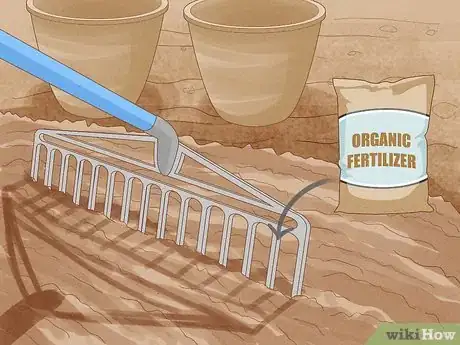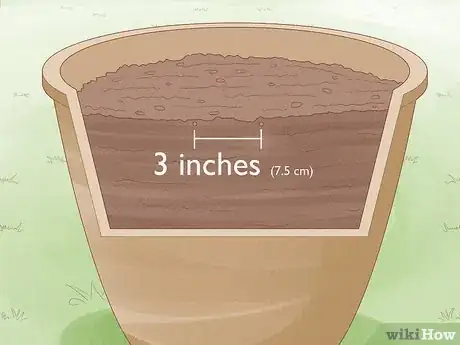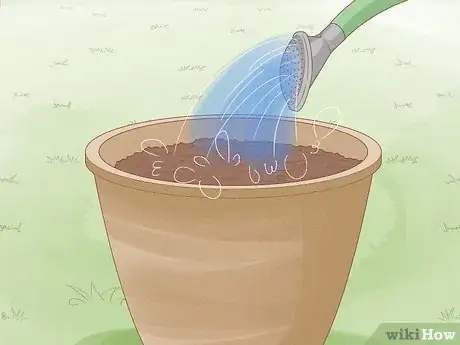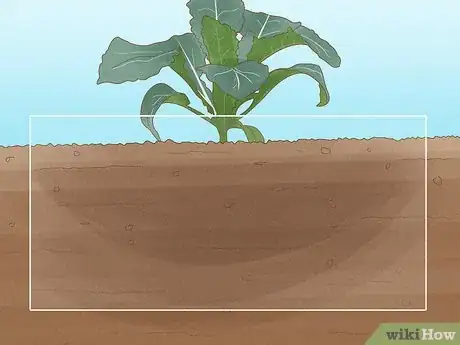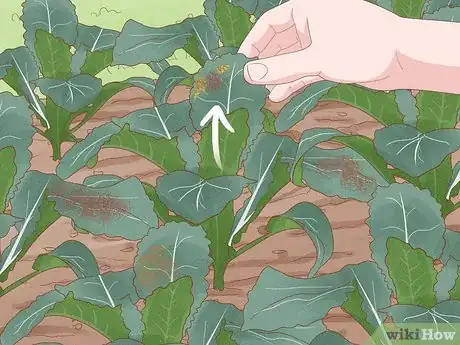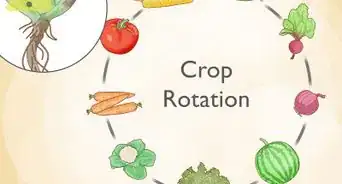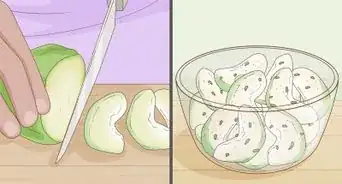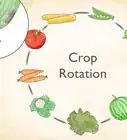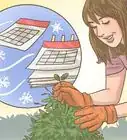This article was co-authored by Andrew Carberry, MPH. Andrew Carberry is a Food Systems Expert and the Senior Program Associate at the Wallace Centere at Winrock International in Little Rock, Arkansas. He has worked in food systems since 2008 and has experience working on farm-to-school projects, food safety programs, and working with local and state coalitions in Arkansas. He is a graduate of the College of William and Mary and holds a Masters degree in public health and nutrition from the University of Tennessee.
wikiHow marks an article as reader-approved once it receives enough positive feedback. In this case, 100% of readers who voted found the article helpful, earning it our reader-approved status.
This article has been viewed 152,563 times.
While kale is generally thought of as a cold weather crop, it is fairly resilient and can tolerate temperatures as low as 20 °F (−7 °C) and as high as 80 °F (27 °C). A dark cooking green, kale hails from the cabbage family as a superfood packed full of essential vitamins and minerals. Follow the steps below to plant your own garden of kale.
Steps
Preparing Your Growing Space
-
1Choose a kale variety that best suits your growing climate. Kale is usually grouped by leaf shape, and although growing times vary between varieties, most kale is ready for harvest between 45 and 75 days after transplanting.
- Curly Kale is sweet and mild and is one of the most commonly found kale varieties. It is characterized by its curly, wrinkled leaves.
- Lacinato or Dino Kale also has a wrinkled texture, though its leaves are tall and skinny.
- Premier Kale is known for its cold hardiness and its ability to grow quickly.
- Siberian Kale is the hardiest variety that (as the name suggests) can withstand harsh temperatures and easily resist pests.
- Red Russian Kale has impressive red twisting leaves. It is similar in its resilience to Siberian kale.
- Redbor Kale is a dramatic deep purple and red kale, perfect for adding color to any dish.
- Walking Stick Kale has a thick stalk that can grow up to six feet tall. The stalk can be used as a walking stick, hence the variety name.[1]
-
2Choose a pot or a garden plot. You will need at least six square inches of growing space per plant regardless of your container type. Choose an area with full sunshine if you’re planting during the fall, and an area with partial shade if you're planting in the spring.
- Avoid low-lying areas and spaces where water tends to collect and/or flood. If you do not have an area with suitable drainage, you can build a raised garden bed.
- Use cedar planks to build your garden bed, as cedar does not rot when it gets wet.
Advertisement -
3Test your soil. Make sure that you plant your kale in fertile, loamy soil, amended with nitrogen, phosphorus, or potassium if it is low in these nutrients. Sandy or clay-like soil will hurt the kale's flavor and production ability. Kale prefers soil with a pH between 5.5 and 6.8.
- If the pH level is below 5.5, enrich the soil to make it less acidic.
- If the soil pH is above 6.8, mix in granular sulfur to lower the pH level.
-
4Know when to plant. If you're starting your seeds or starts indoors, plant them between five and seven weeks before the last frost. If you're going to start your kale outside, plant the seeds two to four weeks before the last frost or at least 10 weeks before the first frost in the fall.[2]
- For kale seeds to germinate, the soil temperature just has to be at least 40 °F (4 °C).
- Kale seeds sprout most effectively in a soil temperature of 70 °F (21 °C).
Growing Kale from Seeds
-
1Mix soil and fertilizer in small pots at least six square inches. Use organic fertilizers and composts when possible. Kale particularly likes fish emulsion and compost tea.
-
2Alternately, churn your garden soil and add fertilizer to sow seeds directly into the garden. Be sure that you sow seeds two to four weeks before the last frost date if you are planting directly in the garden.
- If the plants start to crowd each other as they grow, you can always further thin the plants out to allow for more space between each plant.
-
3Sow seeds under a thin layer of soil. Kale seeds are small and can only grow through ¼ to ½ inch (6–12 mm) of soil. Space the seeds about three inches (7.5 cm) apart. Pat the soil lightly to cover the seeds.[3]
-
4Water the plant thoroughly. While the seeds grow, allow the top layer of the soil to dry out between watering.
-
5Grow the seedlings until they are three to four inches high. At this point, your kale seedlings should have at least four developed leaves. It takes four to six weeks for your seedlings to reach this stage.
Transferring Kale to Your Garden
-
1Spread a thin layer of fertilizer evenly over the growing area. Follow the directions for your specific type of fertilizer for precise amounts. For compost and mulch, spread a layer a few inches deep. For seaweed powder or rock dust, apply a thin, even sprinkle.[4]
-
2Remove the kale seedlings from their container. Do so by gently patting the container on its side if you used plastic pots to start your seedlings. If you purchased kale starts at a garden supply store or nursery instead of starting with seeds, simply remove the purchased seedlings from their plastic containers.
-
3Use your hands or a hand trowel to dig holes 12 to 15 inches (30.5 to 38.1 cm) apart. The holes should be just deep enough to plant the seedlings at the same level they were growing in the pot. If you are planting multiple rows, make sure that the rows are 18 to 24 inches (45.7 to 61.0 cm) apart.
-
4Plant your starts in the holes. Pat the soil down to the same level it was in the plant, without burying any leaves. Make sure to plant the starts perpendicular to the ground, regardless of the shape of the roots.
-
5Water your plants thoroughly.[5]
Caring for and Harvesting Your Kale
-
1Keep the soil around your kale plants moist. Depending on the amount of sun your plants receive, you may have to water them as often as every day.[6]
-
2Fertilize your kale plants during the growing season every six to eight weeks. Fertilizer helps the kale grow strong and robust and keeps it producing healthy, sweet leaves.
-
3Put mulch around the kale if the leaves are rotting or appear discolored. Make sure that the kale is at least six inches tall before you mulch your plants. Mulching helps prevent wet soil from sticking to leaves and molding them.
-
4Pick off any discolored or withered leaves when they appear. Doing so helps to reduce the chance of harmful pests.[7]
-
5Harvest the kale about 70-95 days after sowing and 55-75 days after transferring to your garden. The plant should be at least eight inches tall before you harvest the leaves. Be aware that growing time varies according to each variety, so be sure to look up the appropriate time before harvesting.
- Pick off the outside leaves first if just harvesting individual leaves.
- If harvesting the entire plant, cut the stem down to about two inches above the soil with one clean cut. This will allow the plant to continue to produce leaves.
- Don't leave the leaves on the plant for too long after they are ready for harvest. Doing so will produce bitter, tough leaves.[8]
Expert Q&A
-
QuestionCan the kale plant be trimmed at the top and continue to grow?
 Andrew Carberry, MPHAndrew Carberry is a Food Systems Expert and the Senior Program Associate at the Wallace Centere at Winrock International in Little Rock, Arkansas. He has worked in food systems since 2008 and has experience working on farm-to-school projects, food safety programs, and working with local and state coalitions in Arkansas. He is a graduate of the College of William and Mary and holds a Masters degree in public health and nutrition from the University of Tennessee.
Andrew Carberry, MPHAndrew Carberry is a Food Systems Expert and the Senior Program Associate at the Wallace Centere at Winrock International in Little Rock, Arkansas. He has worked in food systems since 2008 and has experience working on farm-to-school projects, food safety programs, and working with local and state coalitions in Arkansas. He is a graduate of the College of William and Mary and holds a Masters degree in public health and nutrition from the University of Tennessee.
Food Systems Expert Yes, if you provide good growing conditions the plant could re-grow a few leaves after being topped off.
Yes, if you provide good growing conditions the plant could re-grow a few leaves after being topped off. -
QuestionI planted kale the end of August. When is the best time to harvest it?
 Andrew Carberry, MPHAndrew Carberry is a Food Systems Expert and the Senior Program Associate at the Wallace Centere at Winrock International in Little Rock, Arkansas. He has worked in food systems since 2008 and has experience working on farm-to-school projects, food safety programs, and working with local and state coalitions in Arkansas. He is a graduate of the College of William and Mary and holds a Masters degree in public health and nutrition from the University of Tennessee.
Andrew Carberry, MPHAndrew Carberry is a Food Systems Expert and the Senior Program Associate at the Wallace Centere at Winrock International in Little Rock, Arkansas. He has worked in food systems since 2008 and has experience working on farm-to-school projects, food safety programs, and working with local and state coalitions in Arkansas. He is a graduate of the College of William and Mary and holds a Masters degree in public health and nutrition from the University of Tennessee.
Food Systems Expert Kale should be ready to harvest by late October or early November in most climates.
Kale should be ready to harvest by late October or early November in most climates. -
QuestionIs it normal for a white moon kale plant to have large stems growing from the top and bloom flowers, and how would I shear it?
 Community AnswerIt's best to harvest your kale before it matures that far, as the younger they are, the more tender and easy to eat. Snip it down to nearly ground level and allow it to regrow.
Community AnswerIt's best to harvest your kale before it matures that far, as the younger they are, the more tender and easy to eat. Snip it down to nearly ground level and allow it to regrow.
Warnings
- Do not plant kale near beans, strawberries, or tomatoes.⧼thumbs_response⧽
- Pests include cabbage moth caterpillars, grey cabbage aphids, cabbage white butterfly moth caterpillars, snails, and slugs.⧼thumbs_response⧽
References
- ↑ http://ecolocalizer.com/2012/03/25/delicious-nutritious-kale-photo-guide-to-different-varieties/
- ↑ http://www.almanac.com/plant/kale
- ↑ https://www.rhs.org.uk/advice/grow-your-own/vegetables/kale
- ↑ https://www.gardenersworld.com/how-to/grow-plants/how-to-grow-kale/
- ↑ https://www.rhs.org.uk/advice/grow-your-own/vegetables/kale
- ↑ https://www.growveg.com/guides/growing-kale-from-sowing-to-harvest/
- ↑ https://www.growveg.com/guides/growing-kale-from-sowing-to-harvest/
- ↑ http://gentleworld.org/kale-an-easy-beginners-guide-to-growing/#Different varieties of kale
About This Article
To grow kale, start by planting kale seeds indoors 5 weeks before the last frost. Then, once the seedlings are 3-4 inches tall, transplant them into your garden outdoors. After you transplant your kale seedlings, water them regularly so the soil doesn't dry out, and fertilize them every 6-8 weeks during the growing season. You should be able to harvest your kale around 65 days after transplanting it, or whenever it's at least 8 inches tall. For more advice from our Gardening co-author, like how to fix rotting or discolored leaves, scroll down!





